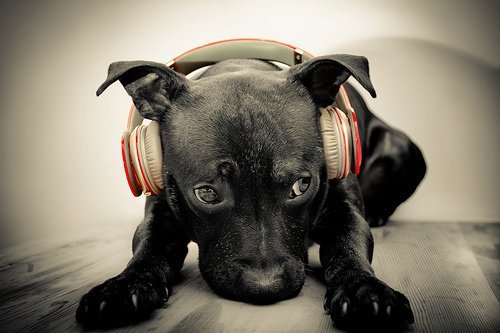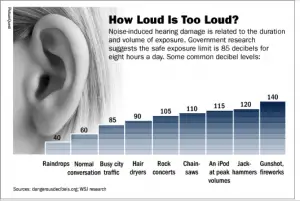Your grandparents are probably hard of hearing- and they grew up in an era without iPods or expensive over-the-ear headphones. Today, a seemingly exponential number of adolescents and young-adults subject their ears to daily ototoxic levels of noise, or noise that is loud enough to cause irreversible hearing loss. As the graph below illustrates, ‘noise-inducing hearing damage is related to the duration and volume of exposure’.
It’s simple- the longer you are subject to noise and the louder the noise is, the worse the damage will be. But how does hearing loss actually happen physiologically? And moreover, why should you be concerned? In order to answer these two simple questions we must first understand how hearing works.
Hearing expert Billy Martin from the Oregon Health & Science University said it best in an article from June of 2011 when he stated, “1our ears are extremely sensitive devices- they’re designed for when you’re walking in the woods and you hear a twig break, signaling that the bear that ate your friend last week is close”. Our ears weren’t made for the constant barrage of noise that my generation has grown-up with.
The process of hearing begins with the transmission of sound waves through the canal that carries sound waves from your visible external ear to the structures of the middle and inner ear that function to transmit mechanical vibrations into sensorineural input that is sent to the brain. First, sound waves hit the tympanic membrane and cause it to vibrate. The tympanic membrane is what you would contact if you shoved a Q-tip as far into your ear as you can (please do not attempt this). It is also what physicians examine when they peer into your ear to assess the general health of your ear. The tympanic membrane causes the subsequent stepwise vibration of three bony ossicles found in the middle ear. These three small bones are the malleolus, incus, and stapes. (Fun fact: the stapes is the smallest bone in the human body at roughly the size of a grain of rice).
As the video below beautifully illustrates, the mechanical vibrations of the stapes cause vibrations to occur within the cochlea that subsequently stimulates sensory inner ear hair cells.
These sensory hair cells release neurotransmitters completing the transformation of mechanical vibrations into sensorineural input that can be interpreted by our brain as sound. These sensory hair cells are of critical importance! For whatever reason, we are only born with 3,500 sensory hair cells- and they do not regenerate. Thus, the root of hearing loss due to old age is via damage to and eventual loss of these sensory hair cells. This is why you should turn down your music- ototoxic levels of noise accelerates the aging process of your ear by damaging the irreplaceable sensory hair cells which induce hearing loss.
Although there are numerous hearing aids available on the market, there are currently no widely accessible regenerative therapies for hearing loss specifically aimed at the regeneration of sensory hair cells. However, a recent discovery by researchers from Massachusetts Eye and Ear and Harvard Medical School grant an optimistic outlook to hearing restoration through regenerative therapies. Researchers applied a drug to stem cells isolated from the ear and were able to restore hearing to deaf mice. 2For the first time ever, researchers demonstrated that “hair cells can be regenerated in an adult mammalian ear”. Senior author Dr. Albert Edge of Harvard Medical School and Mass. Eye and Ear explains that, “With more research, we think that regeneration of hair cells opens the door to potential therapeutic applications in deafness.”
We are still years away from being able to supply commercially available and financially responsible stem cell-based therapies for sensorineural hearing loss to the public, but these findings fuel cautious optimism for the field of regenerative medicine and ultimately give our next generation of hearing impaired individuals a reason to be optimistic about long-term regenerative therapies. However, as with the rest of the human body, the promotion of health and wellness must be implemented as the primary defense against the advancement of the aging process with specific regards to hearing loss. A good rule of thumb for ear safety- if you have headphones on and you cannot hear the person next to you speak then your music is probably too loud (of course, assuming you aren’t wearing noise cancelling headphones).
In the end as much as it pains me to say it- my parents were right once again. Loud music can in fact cause hearing loss and also accelerates damage to irreplaceable sensory hair cells. So do yourself a favor and turn down your music- it’s for your health.
Works Cited
1- Newman, Jim. “How Much Noise…is Too Much Noise?” OHSU News. Oregon Health & Science University, 9 June 2011. Web. 02 Mar. 2013.
2- “Mass. Eye and Ear Researchers Regenerate Sensory Hair Cells, Restore Hearing to Noise-Damaged Ears.” Mass. Eye and Ear Researchers Regenerate Hair Cells, Restore Hearing. Ed. Mary Leach. Massachusetts Eye and Ear, 9 Jan. 2013. Web. 2 Mar. 2013.



Hello just wanted to give you a quick heads up. The text in your content seem to be running off the screen in Internet explorer. I’m not sure if this is a format issue or something to do with web browser compatibility but I thought I’d post to let you know. The layout look great though! Hope you get the problem solved soon. Cheers Christian Louboutin Evening http://buycheapredbottom.webs.com/
Thanks for the heads up!
I think that you could do with some pics to drive the message home a little bit, but other than that, this is great blog. A great read. I will certainly be back.
Thank you for the constructive criticism! In the future I’ll try to use more visuals to explain my point. Its always good to see something from multiple perspectives..especially a complex one like the physiology of hearing.
That is a good tip particularly to those new to the blogosphere. Simple but very accurate information… Thank you for sharing this one. A must read article!
I’m glad you enjoyed it!